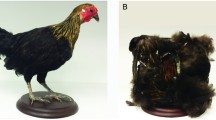Abstract
Male hamsters, reared with their siblings and non-siblings, were tested for their exploratory behavior of conspecific in the 4th and 8th week after their birth. During the tests, a familiar sibling, an unfamiliar sibling, a familiar non-sibling and an unfamiliar non-siblings was presented in a choice box. Subjective distance among these testing animals was measured using the caseV of Thurston's paired-comparison test. The hamsters spent more time with the unfamiliar animals than with the familiar ones. Although biological relation (sibling or non-sibling) had a significant effect in the 4th-week test, only the familiarity determined the investigatory behavior in the 8th-week test. These results suggest sibling recognition based on learning in hamsters.
Similar content being viewed by others

References
Block, M.L., L.C. Volpe, & M.J. Hayes 1981 Saliva as a chemical cue in the development of social behaviour.Sci., 211: 1062–1064.
Borlongan, C. & S. Watanabe (Submitted) Sibling discrimination learning in mice.
Dewsbury, D.A. 1990 Tests of preferences of young deer mice (Peromyscus maniculatus bairdi) for siblings vs nonsiblings.J. Comp. Psychol., 104: 174–182.
Fuller, C.A. & A.R. Blaustein 1990 An investigation of sibling recognition in a solitary sciuroid, townsend's chipmunk,Tamias Townsendii. Behav., 112: 36–51.
Grau, H.J. 1982 Kin recognition in white-footed deermice (Peromyscus leucopus).Anim. Behav., 30: 497–505.
Halpin, Z.T. & M.D. Hoffman, M.D. 1987 Sibling recognition in the white-footed mouse,Peromyscus leucopus: Association on phenotype matching.Anim. Behav., 35: 563–570.
Hepper, P.G. 1983 Sibling recognition in the rat.Anim. Behav., 31: 1177–1191.
Hepper, P.G. 1986 Sibling recognition in the rat: Change in stimulus value or individual preference?Anim. Behav., 34: 607–609.
Hepper, P.G. 1987 The discrimination of different degrees of relatedness in the rat: Evidence for a genetic identifier.Anim. Behav., 35: 549–554.
Holmes, W.G. & P.W. Sherman 1982 The ontogeny of kin recognition in two species of ground squirrels.Amer. Zool., 22: 491–517.
Kareem, A.M. & C.J. Barnard 1982 The importance of kinship and familiarity in social interactions between mice.Anim. Behav., 30: 594–601.
Kareem, A.M. & C.J. Barnard 1986 Kin recognition in mice: Age, sex and parental effects.Anim. Behav., 34: 1814–1824.
Thurston, L.L. 1927 A low of comparative judgement.Psychol. Rev., 34: 415–423.
Turpin, B., T.D. Johnston, & K.R. Fulk 1988 Sibling inhibition of hoarding in postweaning hamster pups (Mesocricetus auratus).Develop. Psychobiol., 21: 467–476.
Author information
Authors and Affiliations
About this article
Cite this article
Watanabe, S., Inada, S. & Borlongan, C. Factor of familiarity in sibling recognition in golden hamsters. J. Ethol. 13, 17–22 (1995). https://doi.org/10.1007/BF02352558
Received:
Accepted:
Issue Date:
DOI: https://doi.org/10.1007/BF02352558



